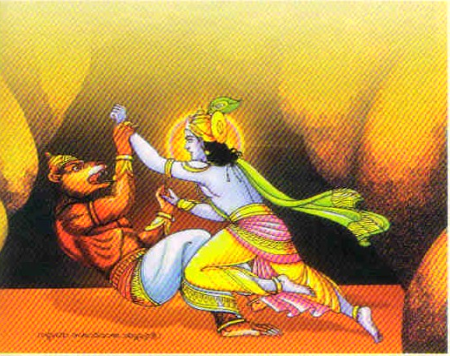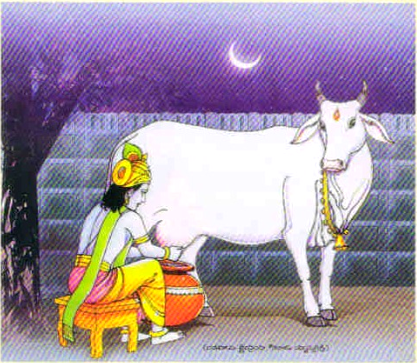Jambavan (जाम्बवान्)
Jambavan (Samskrit : जाम्बवान्) or Jambavanta is well known as the wise old minister (a noble bear) of Sugriva, the Vanara Raja who lived on the Kishkinda mountain of Bharatavarsha. He is also known for his fight with Shri Krishna for Syamantakamani (a precious ornament gifted by Surya) described in Bhagavata Purana. Thus his role in Ramayana and Bhagavata Purana is well discussed. There are different versions that Jambavan was described as a monkey and a bear.
In some of the Ramayana versions in Indian languages he is described as a monkey. In some versions he was described as a monkey existing from an ancient period even prior to incarnation of Shri Rama. Jambavan is said to have witnessed nine out of the ten incarnations of Mahavisnu, thus he is known for his longevity.[1]
Birth and Family
Birth
In Valmiki Ramayana, Jambavan is described as Rksapungava (ऋक्षपुङ्गव: । foremost of bears) who was created from Brahma.
पूर्वमेव मया सृष्टो जाम्बवानृक्षपुङ्गव:। जृम्भमाणस्य सहसा मम वक्त्रादजायत।।1.17.6।। (Valm. Rama. 1.17.6)[2]
Brahma says - earlier Jambavan, the Rkshapungava, the foremost among bears arose from my face at the instance of my yawning.[1]
Family
Marjara, was the son of Jambavan. It is said in Brahmapurana that the marjaras (cats) have their origin from this son of Jambavan. (Page 488 and 491, Puranic Encyclopedia)[1].
Sri Krsna married Jambavati the daughter of Jambavan described in the Samantopakhyana of many texts (Puranas, Mahabharata).
Grandchildren of Jambavan : Shri Krishna and Jambavati's children include Bhadra, Bhadragupta, Bhadravinda and Saptabahu were the sons and Sambhodani and Bhadravati were the daughters. (Vayupurana 2.34.241)[3]
Jambavan in Ramayana
When the troubles and hardships caused by the wickedness of Ravana became unbearable the goddess Earth and the Devas approached Brahma for redress. Brahma took them to Vaikuntha, where Mahavisnu heard everything and said that he would incarnate as the son of Dasaratha and would kill Ravana. As Mahavishnu took the avatara of Shri Ramachandra, Brahma directed chiefs of Apasara and Gandharvas to create an army of monkeys to help Shri Rama on that occasion. Accordingly Brahma created Jambavan (earlier than Rama's incarnation) and several other monkeys. Distinguished rshis, siddhas, vidyadharas, uragas, charanas procreated heroic sons in the form of monkeys who became forest-dwellers.
During the time of Shri Rama, Jambavan was the minister of Sugriva. It is stated in Valmiki Ramayana, Kiskindha Kanda, Sarga 41, that Nila, the son of Agni, Hanuman, Jambavan, Suhotra, Sarari, Saragulma, Gaja, Gavaksa, Gavaya, Susena, Rsabha, Mainda, Dvivida, Vijaya, Gandhamadana, Ulkamukha, Asanga, Angada and others were the ministers of Sugriva.
नील मग्निसुतं चैव हनुमन्तं च वानरम्। पितामहसुतं चैव जाम्बवन्तं महाबलम्।।4.41.2।। (Valm. Rama. 4.41.2)[4]
Hanuman, Nila, Angada and Jambavan were the formidable troop of monkeys sent by Sugriva in the southern direction in search of Sita. On reaching the southern seas, the question was how to jump over the sea to Lanka. They were previously informed by Sampati that Sita was in the Asoka vana as a captive of Ravanasura. Each of them came forward to show his ability and admitted failure. Finally Jambavan called Hanuman and advised him to jump over to Lanka.
In Vamana Avatara
Bhagavata Purana mentions Jambavan as follows
जाम्बवान् ऋक्षराजस्तु भेरीशब्दैर्मनोजवः । विजयं दिक्षु सर्वासु महोत्सवमघोषयत् ॥ ८ ॥ (Bhaga. Pura. 8.21.8)[5]
Jambavan, the rksharaja, (moving) with the speed of the mind, proclaimed with beating of drums in all directions, the victory of Mahavishnu (over Bali Chakravarty) and the great festive occasion.[6][1]
In the assembly of monkeys searching for Sita in the southern direction each monkey was discussing their individual capacity to leap across the sea. When asked about his ability Jambavan replied that he went around Mahavisnu, who took the avatar of Trivikrama Vamana to curb the powers of Mahabali. At that time Jambavan was immensely strong. But by the time of the incarnation of Sri Rama his strength had decreased much. Thus in Valmiki Ramayana he quotes his abilities thus,
"My abilities in olden times were not what you see now. In the far old days, I had walked round that Eternal Being Visnu when he measured three steps at the sacrifice of Mahabali. Now, I am very old and have not enough strength to jump over the sea." (Valmiki Ramayana, Kiskindha kanda, Sarga 65).
मया महाबलेश्चैव यज्ञे विष्णुस्सनातनः। प्रदक्षिणीकृतः पूर्वं क्रममाणस्त्रिविक्रमम्।।4.65.15।। (Vakm. Rama. 4.65.15)
स इदानीमहं वृद्धः प्लवने मन्दविक्रमः। यौवने च तदाऽसीन्मे बलमप्रतिमं परैः।।4.65.16।। (Vakm. Rama. 4.65.16)[7]
From this sloka it may be noted that Jambavan existed way before Shri Rama took avataram on the earth.
Motivating Hanuman
Hanuman who was not aware of his own strength, did not come forward and stayed quiet. Jambavan told him about his birth, strength, attainment of boons etc. Hanuman became convinced of his powers at the words of Jambavan and jumped over the sea to Lanka.
Once due to a curse of sage Trnabindu, Hanuman lost his great strength and vitality. But, the remedy given was that he would regain the lost power when anyone reminded him of it. During the search for Sita Hanuman felt it difficult to jump across the southern sea to Lanka due to the above curse. But, when Jambavan described to him about his noble origin and powers Hanuman regained his lost power and vitality, and successfully jumped across the sea to Lanka.[1]
Sarga 66 of Kishkinda Kanda of Valmiki Ramayana[8] describes the glory of Hanuman by Jambavan and how he inspires Hanuman to take the leap over the ocean to reach Lanka. This also shows the skill, knowledge and wisdom of the old minister of Sugriva.
Jambavan and Sahadeva
During this period nothing was heard of Sugriva,Hanuman and Jambavan in Kiskindha. Might be Sugriva was no more. Hanuman, after Shri Rama, lived in Gandhamadana in Kimpurusavarsa. (Bharata and Bhagavata, 10th Skandha) .
In South India, at the southern tip of the Sahya ranges, a mountain reputed for medicinal herbs., may still be seen. This mountain is known by the name "Marutvamala". A legend- connected with the origin of this mountain, is given in Uttara Ramayana as follows:- “It was the time of the battle between Rama & Ravana. Ravana's younger brother Vibhisana, joined the side of Rama and fought against Ravana. The enraged Ravana shot his arrow at Vibhisana. In his endeavour to save Vibhisana, Laksmana fell down unconscious. Rama and his followers discussed how Laksmana could be revived. Jambavan observed that there was a herb called "Dronam" in one of the peaks of the Himalayas and if it was brought at once, Laksmana could be restored to his senses. Hanuman flew; to the Himalayas immediately. But although he combed the forests there, he was not able to find the herb: Dronam. So he tore away and lifted a whole peak which was full of all kinds of medicinal herbs and returned to Lanka. Jambavan took the needed herbs from it and deposited the peak at the southern end of India. This is the present Marutvamala. (Mala means mountain). (Page 491, Puranic Encyclopedia - Vettam Maṇi)
MRTASANJIVANI. This is a medicinal herb to give life to those who are dead. When in the Rama-Ravana battle Laksmana and others fell dead, Sri Rama wanted Mrtasanjivani to be brought to revive them back to life. Jambavan the oldest among the monkey-warriors then instructed Hanuman to get it from the mountain Mahameru. (Page 505, Puranic Encyclopedia - Vettam Maṇi)
Armies of many lakhs of monkeys were deputed to the eight regions to search for Slta. Susena was appointed chief of the army for the west, Satabali for the north, Vinata for the east and Angada for the south. As the south was the chief place for the search, monkeys like Hanuman,Jambavan, Vivida, Nala, Nila, Kumuda, each of them an expert in various ways, were appointed chiefs of different matters. Every chief and his assistant was given suitable instructions by Laksmana and Sugriva, and accordingly the army of monkeys began its march under the leadership of Hanuman.
Soon after Sri Rama entered Lanka, Ravana sent Suka and Sarana to Sri Rama's camp. After taking a distant view of the surroundings, they entered the camp of Sri Rama in the form of monkeys. Taking care not to come within the observation of Vibhisana, they went about the military camps, gathering secret information. Just then they were met by Jambavan and Hanuman. After closely observing them for a considerable time, they understood that they were enemy spies. The monkey-heroes promptly seized them and produced them before Sugriva. (Page 758, Puranic Encyclopedia - Vettam Maṇi)
Syamantakopakhyana
Many Puranic texts have mentioned about Jambavan being seen in Dvapara Yuga, in connection with the precious stone Syamantaka. This upakhyana (anecdote) during the avatara of Shri Krishna is famous because Jambavan gives his daughter Jambavati as the wife of Shri Krishna. Jambavan is one among the chiranjeevi's (a long lived being) is evident in this story.
Different Puranas recount this anecdote
- Brahma Purana (Adhyayas 16 and 17)[9]
- Brahmanda Purana (2.3.71. 22-29)
- Vayu Purana (2.34.21-52)[3]
- Harivamsa (Adhyaya 38)
- Padma Purana (Kanda 1 Adhyaya 13 Slokas 71 to 93)[10]
The Sun-god gave this jewel Syamantaka to King Satrajit. His younger brother Prasena wore it and went to the forest for hunting. A lion killed him and took the jewel in his mouth and was going along the forest when Jambavan killed it and took the jewel. It was rumoured that Sri Krsna had killed Prasena and taken the jewel.
So to clear himself of the false charges Shri Krsna went in search of the jewel to the forest, and found the body of Prasena and his horse. Seeing the footprints he found that a lion had killed them. A few steps away he found the body of the lion and that a bear's prints. Following the footprints Shri Krishna arrives at the mountain cave of Jambavan. Inside the cave a small boy was being consoled saying "Don't cry, here is Syamantaka mani". Understanding that bear killed and took the jewel from the lion, Shri Krishna fights with Jambavan for 21 days (another version is 27 days), and defeats him. In the duel that ensued between Jambavan and Krsna the former was defeated. He recognised Krsna to be the Lord, and presented Syamantaka and also his daughter JambavatI to Krsna and JambavatI thus became Krsna's wife. (Page 425, Puranic Encyclopedia)[1]. Accepting defeat Jambavan offers the Syamantaka mani along with his daughter Jambavati in marriage to Shri Krishna. Upon return with his retinue to Dwaraka, Shri Krishna returned the mani to Satrajit and clears false accusations on him. Satrajit offers his daughter Satyabhama to Shri Krisna on knowing the true events. (Bhagavata, Skandha 10).
From the story of Prasena it may be seen that Jambavan left Kiskindha and lived in the cave of Rkshavan with his sons and other relations.
ऋक्षवन्तं गिरिवरं विन्ध्यं च गिरिमुत्तम्। अन्वेषयन् परिश्रान्तः स ददर्श महामनाः॥ १६.३१ ॥ (Brah. Pura. 16.31)[9]
Page 603, Puranic Encyclopedia - Vettam Maṇi)
References
- ↑ 1.0 1.1 1.2 1.3 1.4 1.5 Mani, Vettam. (1975). Puranic encyclopaedia : A comprehensive dictionary with special reference to the epic and Puranic literature. Delhi:Motilal Banasidass. (Page 613 and 614)
- ↑ Valmiki Ramayana (Balakanda Sarga 17)
- ↑ 3.0 3.1 Vayu Purana (Uttarartha Adhyaya 34)
- ↑ Valmiki Ramayana (Kishkinda Kanda Sarga 41)
- ↑ Bhagavata Purana (Skanda 8 Adhyaya 21)
- ↑ Tagare, Ganesh. Vasudeo. The Bhagavata Purana, Part 3. Delhi : Motilal Banasidass Pvt. Ltd.
- ↑ Valmiki Ramayana (Kishkinda Kanda Sarga 65)
- ↑ Valmiki Ramayana (Kishkinda Kanda Sarga 66)
- ↑ 9.0 9.1 Brahma Purana (Adhyaya 16)
- ↑ Padma Purana (Khanda 1 Adhyaya 13)

